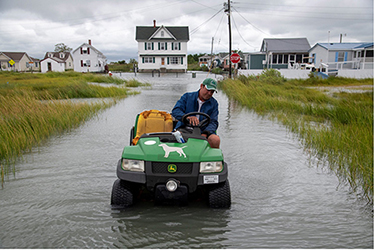Climate adaptation laws and policies do not yet center climate justice goals. Legislative frameworks, solicitation language and funding criteria are restricting community access to nature-based climate adaptation funding. These aspects of federal and state funding systems manifest in climate adaptation programs that perpetuate and even exacerbate systemic inequities.
Environmental justice and equity are frequently acknowledged as being important considerations for grant programs but are inconsistently and inadequately used to guide the fair and equitable allocation of coastal climate adaptation resources. With worsening impacts of climate change, there is an urgent and increasing need to address the climate adaptation priorities of underserved and frontline communities.
For the first time in our history, the U.S. Federal Government has acknowledged the impact of centuries of racism and marginalization that have led to inequitable distribution of resources.
 Through the Justice40 Initiative, the U.S. Federal Government has made it a goal that 40 percent of the overall benefits of certain Federal investments flow to disadvantaged communities that are marginalized, underserved and overburdened. This is an important first step toward redistributing resources more equitably to communities that are most impacted.
Through the Justice40 Initiative, the U.S. Federal Government has made it a goal that 40 percent of the overall benefits of certain Federal investments flow to disadvantaged communities that are marginalized, underserved and overburdened. This is an important first step toward redistributing resources more equitably to communities that are most impacted.
As these advancements are being made at the Federal level, it's critical to integrate these equity principles into state-level funding decisions and to determine if the changes are achieving their intended community climate equity goals.
A "covered program" is a Federal Government program that falls in the scope of the Justice40 Initiative because it includes investments that can benefit disadvantaged communities across one or more of the following seven areas: climate change, clean energy and energy efficiency, clean transit, affordable and sustainable housing, training and workforce development, remediation and reduction of legacy pollution and the development of critical clean water and wastewater infrastructure.
There is a need to identify how the concept of Justice 40 is being applied to coastal communities, and their climate adaptation priorities. For example, the National Oceanic and Atmospheric Administration (NOAA) as the primary agency overseeing the nation's coastal and ocean resources only recently announced a list of Justice40 specific funding programs. There are additional barriers across all stages of federal and state funding systems that restrict coastal communities' access to climate adaptation funds.
 In 2021, TNC hired Upwelling Consulting to review the lifecycle of climate adaptation funding in five US states including Maryland, California, Louisiana, New York and North Carolina to identify inequities in laws, policies and programs, as well as opportunities for improvement to increase equitable access to, and distribution of, climate adaptation funding.
In 2021, TNC hired Upwelling Consulting to review the lifecycle of climate adaptation funding in five US states including Maryland, California, Louisiana, New York and North Carolina to identify inequities in laws, policies and programs, as well as opportunities for improvement to increase equitable access to, and distribution of, climate adaptation funding.
The cross-state analysis of climate adaptation programs revealed three general patterns, and while this analysis isn't comprehensive of all the inequities that exist, it provides a starting point for our work in Maryland.
